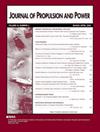Deflagration to Detonation Transition in Heterogeneous Mixtures Containing Ethanol/Acetone and Oxygen
IF 2.4
4区 工程技术
Q2 ENGINEERING, AEROSPACE
引用次数: 0
Abstract
Liquid fuel is the choice for volume-limited propulsion systems, including detonation-based propulsion. A liquid fuel with high vapor pressure has the advantage of more fuel vapor in the mixture, which supports the transition from deflagration to detonation. This paper reports on an experimental study of deflagration-to-detonation transition (DDT) in a pulse detonation engine with heterogenous mixtures of oxygen and ethanol or acetone. Single-cycle tests were taken for different fuels, equivalence ratios, and DDT enhancement methods. The size distribution of fuel droplets was characterized at the atomizer and engine exit. The effect of the fuel evaporation was dominant for the acetone spray only. Comparing the measured detonation velocities of the two mixtures, a lower velocity deficit relative to the theoretical Chapman–Jouguet detonation velocity was measured for the acetone–oxygen mixtures, and this behavior is related to the higher amount of fuel vapor that existed in the mixtures. Moreover, a shorter transition to detonation was observed in the acetone–oxygen mixture. The addition of a Shchelkin spiral reduced the DDT distance; however, the Chapman–Jouguet condition could be reached only downstream of the obstacle. The measured detonation cell size of the heterogeneous acetone–oxygen mixture was smaller than that of the ethanol–oxygen mixture, indicating that it is more detonable.含乙醇/丙酮和氧气的非均质混合物的爆燃-爆轰转变
液体燃料是体积有限的推进系统的选择,包括基于爆炸的推进系统。高蒸气压的液体燃料的优点是混合气中有更多的燃料蒸气,这支持了从爆燃到爆轰的过渡。本文报道了在氧与乙醇或丙酮异质混合物的脉冲爆轰发动机中爆燃-爆轰过渡(DDT)的实验研究。对不同燃料、当量比和DDT增强方法进行了单循环试验。对喷雾器和发动机出口处燃油液滴的大小分布进行了表征。燃料蒸发对丙酮喷雾的影响是主要的。通过对比两种混合物的爆轰速度,发现丙酮-氧气混合物的爆轰速度比理论的Chapman-Jouguet爆轰速度差小,这与混合物中存在较多的燃料蒸气有关。此外,在丙酮-氧混合物中观察到较短的爆轰过渡。谢尔金螺旋的加入减少了滴滴涕距离;而chapman - jougette条件只能在障碍物下游达到。测得异相丙酮-氧混合物的爆轰池尺寸小于乙醇-氧混合物,表明其更易爆轰。
本文章由计算机程序翻译,如有差异,请以英文原文为准。
求助全文
约1分钟内获得全文
求助全文
来源期刊

Journal of Propulsion and Power
工程技术-工程:宇航
CiteScore
4.20
自引率
21.10%
发文量
97
审稿时长
6.5 months
期刊介绍:
This Journal is devoted to the advancement of the science and technology of aerospace propulsion and power through the dissemination of original archival papers contributing to advancements in airbreathing, electric, and advanced propulsion; solid and liquid rockets; fuels and propellants; power generation and conversion for aerospace vehicles; and the application of aerospace science and technology to terrestrial energy devices and systems. It is intended to provide readers of the Journal, with primary interests in propulsion and power, access to papers spanning the range from research through development to applications. Papers in these disciplines and the sciences of combustion, fluid mechanics, and solid mechanics as directly related to propulsion and power are solicited.
 求助内容:
求助内容: 应助结果提醒方式:
应助结果提醒方式:


